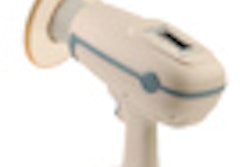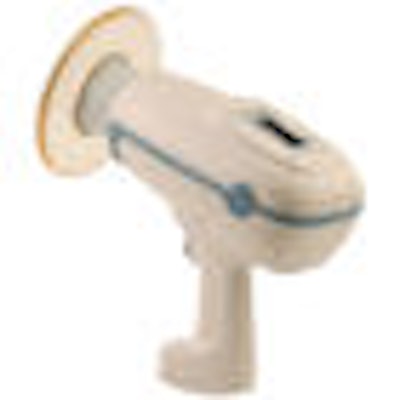
It may look like something out of a sci-fi movie, but the Nomad portable x-ray system from Aribex is taking the notion of "ray gun" to a whole new level, especially in dentistry.
Five years ago, the idea of a handheld, battery-powered, intraoral x-ray device was little more than that -- a nifty idea. Portable x-ray systems have been around for years, but they can be cumbersome and restrictive. Dentists operating in humanitarian or forensic field situations, for example, need compact, lightweight, and, most important, truly portable instruments -- that is, untethered from wall mounts and wall sockets.
Enter Aribex, a company founded in 2003 to develop new forms of x-ray technologies for medical and industrial applications. Founder and president Clark Turner, Ph.D., says he got the idea for the company's flagship product, the Nomad, from conversations with his dentist.
"I was working on miniature x-ray tubes, and he was going to Russia to do humanitarian work," Turner said in an interview with DrBicuspid.com. "He was intrigued with the idea of mini x-ray tubes and said there was a need for a battery-powered x-ray device in dentistry. Everything at the time was 20 lbs and had to be plugged into the wall and set on a tripod."
By 2005, Turner had produced a prototype of the Nomad, a handheld intraoral x-ray system that looks much like a construction drill but operates like a conventional wall-mounted radiography system. It can accommodate digital sensors or film and utilizes a 14.4-volt nickel-cadmium battery that provides up to 700 exposures on a single charge. The Nomad is designed for general-purpose dental use and is particularly helpful when working with children, sedated patients, or special needs patients. In operation, the technician stands next to the patient, positions the device, and takes the radiograph. This saves time, shortens the time the patient has to sit still with film or a sensor in their mouth, and reduces retakes, according to the company.
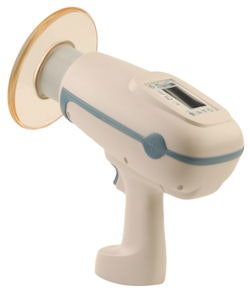 |
| The Nomad portable x-ray system by Aribex. All images courtesy of Aribex. |
"There are certain procedures where this has a particular advantage, such as endodontic procedures where the practitioner has a drill or file in the tooth and they don't want to move away from the patient," Turner said. "The other really good application is oral surgery, where the rooms are typically too big to make a wall-mount system practical so the oral surgeons use mobile x-ray systems. It was also designed for out-of-office applications; my dentist uses it every Friday at the homeless shelter where he does volunteer work."
Aribex gained FDA clearance for the Nomad in July 2005 and introduced it commercially in 2006, selling for around $7,000. While the device is a little pricier than a wall-mount system, which typically sells for around $4,000, Turner points out that with the Nomad, if you have multiple operatories, you don't need multiple wall-mounted systems. It also eliminates the construction costs associated with reinforcing walls and installing electrical hookups.
"The FDA has a performance standard for intraoral x-ray machines, so as long as you meet these performance standards, it is pretty easy to get approved," Turner said. "It's all about repeatability of the dose and accuracy of the timers. And the FDA regulations don't require it to be mounted on a wall."
Radiation exposure
Unfortunately for Aribex, most state dental boards are stricter in their regulation of dental x-ray systems. The company has spent the last three years going state by state to gain the necessary clearances to allow dentists to use the Nomad. So far 37 have said OK, according to Turner.
The very thing that makes the Nomad so unique -- the ability to have the operator stay in the room, next to the patient, while x-rays are taken -- is also the source of the biggest concern for many state boards: radiation exposure. Thus Aribex has conducted numerous studies to show that the Nomad is safe for users and patients alike, Turner said. Authors of a paper published in Dentomaxillofacial Radiology (February 2008, Vol. 37:2, pp. 109-112), for example, concluded that "Our data have shown that the Nomad presents risks that are no greater than with standard dental radiography units to the patient or operator and the measured doses are well below recommended levels."
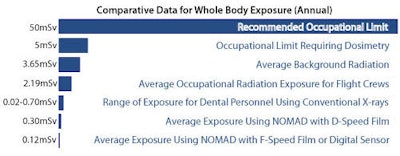 |
The key to making the device safe is the proprietary lead-filled acrylic backscatter shield attached at the end of the cone, Turner said. Radiation studies conducted by Aribex found that in a "worst case" situation -- taking 60 exposures per hour at a maximum exposure of 0.99 seconds each -- an operator has the potential to receive 3.6 mR/hr leakage at the hand. The maximum allowable radiation leakage, per FDA regulations, is 100 mR/hr.
Still, some state dental boards remain unconvinced. In addition, an evaluation of the Nomad conducted by the U.S. Air Force Dental Evaluation and Consultation Service in 2006 noted that "with some patient positions the backscatter shield count not provide the operator with maximum shielding."
"There are some concerns about operator safety, as evidenced by the number of states that have not approved or restrictively approved the use of the Nomad," said Edwin Parks, D.M.D., M.S., the director of dental radiology at the Indiana University School of Dentistry in Indianapolis. "We had a health physicist assess the Nomad for scatter and found minimal exposure to the operator. We sent the information to the state office that deals with radiologic health, and they still chose not to approve the use of the Nomad in the state of Indiana."
Likewise, research conducted by Robert Danforth, D.D.S., an associate professor of radiology at the University of Nevada Las Vegas (UNLV), and Ed Herschaft, D.D.S., M.A., a professor of biomedical sciences at UNLV, for the radiology section of the state of Nevada found that "when used as shown in the manufacturer's brochures, the protection shield provides appropriate operator protection."
However, if the operator is positioned in an atypical position, a small dose to the reproductive area was detected, Dr. Danforth said. "This is the result of not always being totally within the 'safe zone' of the protection shield," he stated in an e-mail to DrBicuspid.com. "Personnel and patients in adjacent cubicles were not at risk, but assistants/personnel directly involved should not stand within 6 feet of the primary beam pathway." Scatter dose off of the patient and to adjacent areas was negligible at the 6-foot range from the patient's head and generally corresponded to the direction of the primary beam, he added.
Blurring?
The very thing that protects users from radiation exposure -- the lead-based backscatter shield -- also makes the Nomad heavier than some prefer, prompting some speculation about image quality. While customers are generally positive about the handheld, tetherless concept of the Nomad, there have been complaints that, at 8.5 lb, the initial system was tiring to use, according to Turner. The company thus reworked the design -- eliminating the lead lining in the collimator and replacing it with silicon infused with heavy inert nontoxic metals -- and launched a lighter version, the 5.5 lb Nomad Pro, earlier this year.
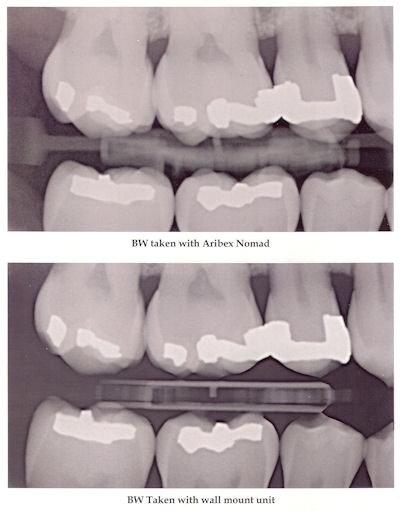 |
"My biggest concern regarding the Nomad is the weight of the product," Dr. Parks said. "The new one is a lot lighter than the original model, but it is still heavy if you are taking more than a couple of images. Other than that, I think the Nomad has a number of useful applications for dentistry."
With regard to image quality, Turner said that blurring isn't possible with the short exposure time: 0.2-0.3 seconds. Also, the Nomad uses the smallest focal spot available (0.4 mm), which Turner said further improves the image quality.
Dr. Danforth noted that the image quality can vary depending on what type of film is used. The UNLV dosimetry studies involving digital sensors and F-speed film resulted in image quality "well within [the] acceptable range and not blurred, as some uninformed individuals want to imply," he told DrBicuspid.com. Ultra D-speed film, however, requires a longer exposure and could be subject to some motion artifact, he added.
"In general, I have favorable views concerning the newer version of the Aribex Nomad for use in making a limited number of exposures, such as bitewings and occasional periapicals," Allan Farman, B.D.S., M.B.A., Ph.D., D.Sc., a professor of radiology at the University of Louisville of Kentucky, stated in an e-mail to DrBicuspid.com. "I was not so impressed by the older version, as the battery was quite heavy and use could tire the operator, which in turn could lead to motion unsharpness. The newer version uses much lighter batteries and is a vast improvement."
Dr. Farman also noted that, while the Nomad is well-suited to operative radiology in which the baseline is a digital panoramic radiograph, he does not see the Nomad as a sensible alternative for making the traditional full-mouth intraoral x-ray series as a baseline on new patients or for periodic review.
"However, I am not a protagonist of the full-mouth intraoral survey, given improved image quality with the newer panoramic systems," he added.






